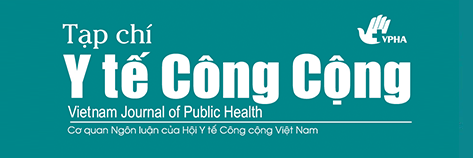Kiến thức, thái độ và thực hành của người dân phường Trung Dũng và Tân Phong, thành phố Biên Hòa về dự phòng nhiễm độc Dioxin qua thực phẩm (Knowledge, attitude and practice of local residents at Trung Dung and Tan Phong wards, Bien Hoa city – Viet Nam on preventing dioxin exposure through foods)
Tóm tắt
Sân bay Biên Hòa là nơi được quân đội Mỹ sử dụng làm nơi chứa chất diệt cỏ (phần lớn là chất da cam, có chứa tạp chất dioxin) trong chiến dịch RANCH HAND. Các thùng chứa những hóa chất này bị rò rỉ, các hoạt động pha chế, rửa máy bay… diễn ra tại đây dẫn đến tình trạng ô nhiêm dioxin trong đất, thực phẩm và trong máu của người dân ở trong và gần khu vực sân bay ở mức cao. Hội Y tế công cộng Việt Nam đã thực hiện một nghiên cứu mô tả cắt ngang với mục tiêu tìm hiểu kiến thức, thái độ và hành vi của 400 người dân sống tại phường Trung Dũng và phường Tân Phong, thành phố Biên Hòa về dioxin và dự phòng nhiễm độc dioxin qua thực phẩm. Kết quả của nghiên cứu cho thấy mặc dù sống trên vùng ô nhiễm dioxin nặng nhưng rất ít người dân có nhận thức và thực hành đúng về vấn đề này trong khi đó các nhóm thực phẩm có nguy cơ nhiễm dioxin cao đươc tiêu thụ khá phổ biến tại địa phương. Tuy nhiên, phần lớn người dân đều có thái độ tích cực về thực hành dự phòng nhiễm độc, kể cả giải pháp mua thực phẩm không bị ô nhiễm dioxin với giá cao hơn. Nghiên cứu này cho thấy cần tiến hành một can thiệp nhắm nâng cao nhận thức, thực hành của người dân tai 2 phường này cũng như nghiêm cấm mọi hành vi chăn nuôi gia súc, gia cầm và cá tại sân bay Biên Hòa và một số khu vực gần sân bay.
English abstract
Bien Hoa Airbase served as a bulky storage and supply facility for Agent Orange during the Operation Ranch Hand. Herbicides are known to have been spilled at this site for several times at large volumes. Consequently, samples of soil, sediment, blood and some types of local foods in Bien Hoa City had elevated levels of dioxin. The Viet Nam Public Health Association undertook a crosssectional study which aimed to describe knowledge, attitude, and practice of 400 randomly selected households representatives in Trung Dung and Tan Phong wards, Bien Hoa City on dioxin and measures to prevent dioxin exposure through foods. The results show that in spite of currently living in one of three worst dioxin hot-spots in Viet Nam, local people in the 2 studied wards have very limited knowledge and practice on dioxin and preventive measures. Dioxin high risk foods were frequently presented in their daily and weekly meals. Nevertheless, they have a very positive attitude toward prevention, including purchasing safe foods at higher prices. The results of this study show that an intervention program to raise local peoples awareness on dioxin high - risk foods and to ban all agricultural activities at highly polluted areas in Trung Dung and Tan Phong wards is urgently needed.
Từ khóa
Toàn văn:
PDF (English)##submission.citations##
Dwernychuk LW, Hung TM, Boivin TC, Bruce GS, Dung PT, Son TK, Hatfield CT, Dung NT, Allan JA, Nhu DD, Thuc PV, Moats DJ, Borton L (2006), The agent orange dioxin issue in Vietnam: A manageable problem, Hatfield, Paper presented in Oslo Conference.
Esposito M, Tiernan T, and Dryden F (1980) Dioxins, U.S. Environmental Protection Agency, Office of Research and Development, EPA-600/2-80-197, Cincinnati, Ohio.
Palmer MG (2005). The legacy of agent orange: empirical evidence from central Vietnam. Social Science & Medicine. 60: 1061-1070.
Schecter A, Dai LC, P#pke O, et al. (2001). Recent dioxin contamination from Agent Orange in residents of a southern Vietnam city. Journal of of Occupational and Environmental Medicine. 43: 435– 443.
Schecter A, Pavuk M, Constable JD, et al. (2002). A follow-up: high level of dioxin contamination in Vietnamese from Agent Orange, three decades after the end of spraying [Letter]. Journal of Occupational and Environmental Medicine. 44: 218 –220.
Schecter A, Quynh HT, Pavuk M, Papke O, Malish R,Constable JD (2003). Food as a source of dioxin exposure in the residents of Bien Hoa City, Vietnam. Journal of Occupational and Environmental Medicine. 45 (8):781–788.
Stellman JM, Stellman SD, Christian R, Weber T and Tomasallo C (2003). The extend and patterns of usage of agent orange and other herbicides in Vietnam. Nature. 422: 681-687.
World Health Organization, Assessment of the health risks of dioxins: re-evaluation of the Tolerable Daily Intake (TDI). Executive Summary.



